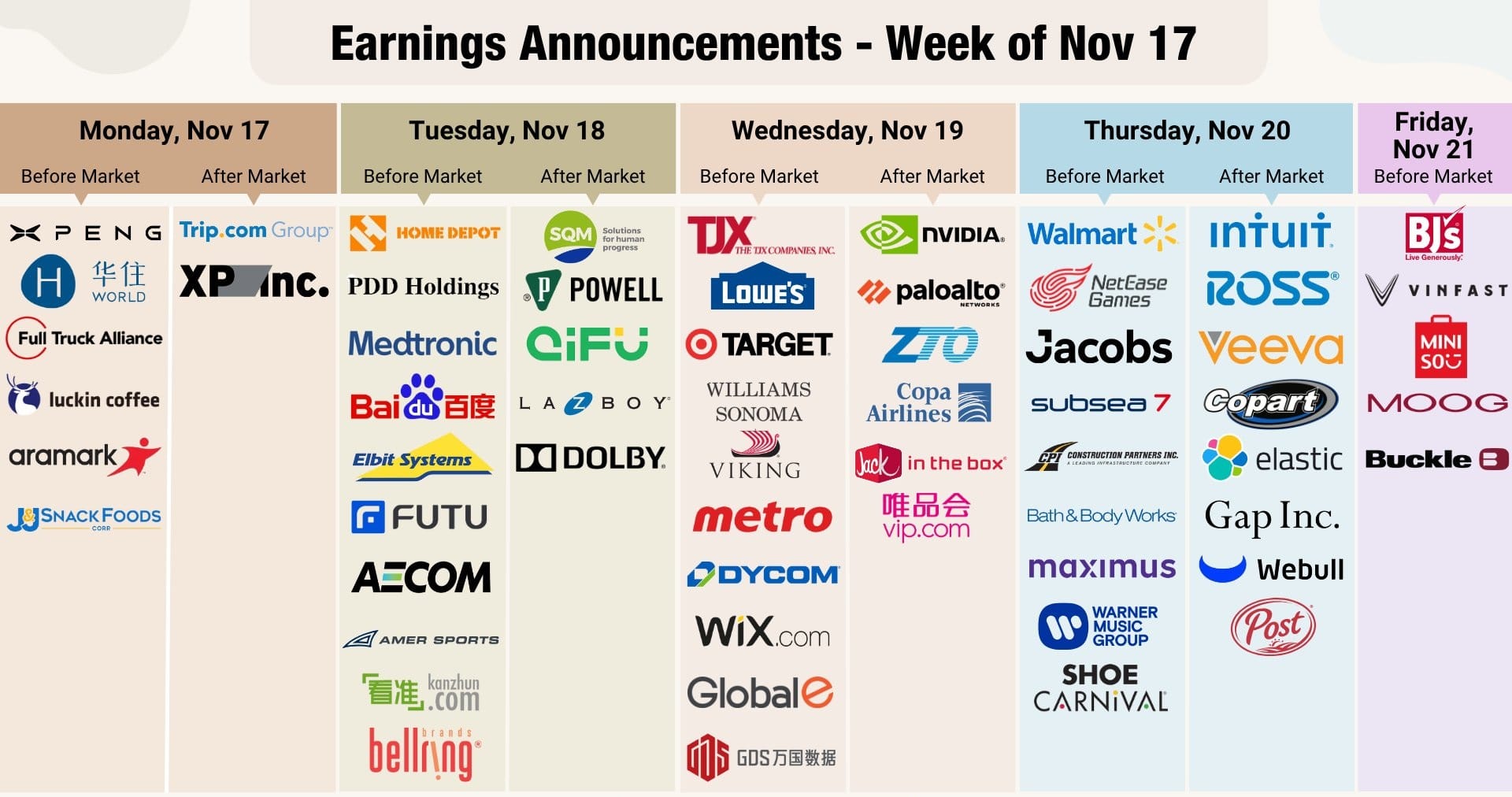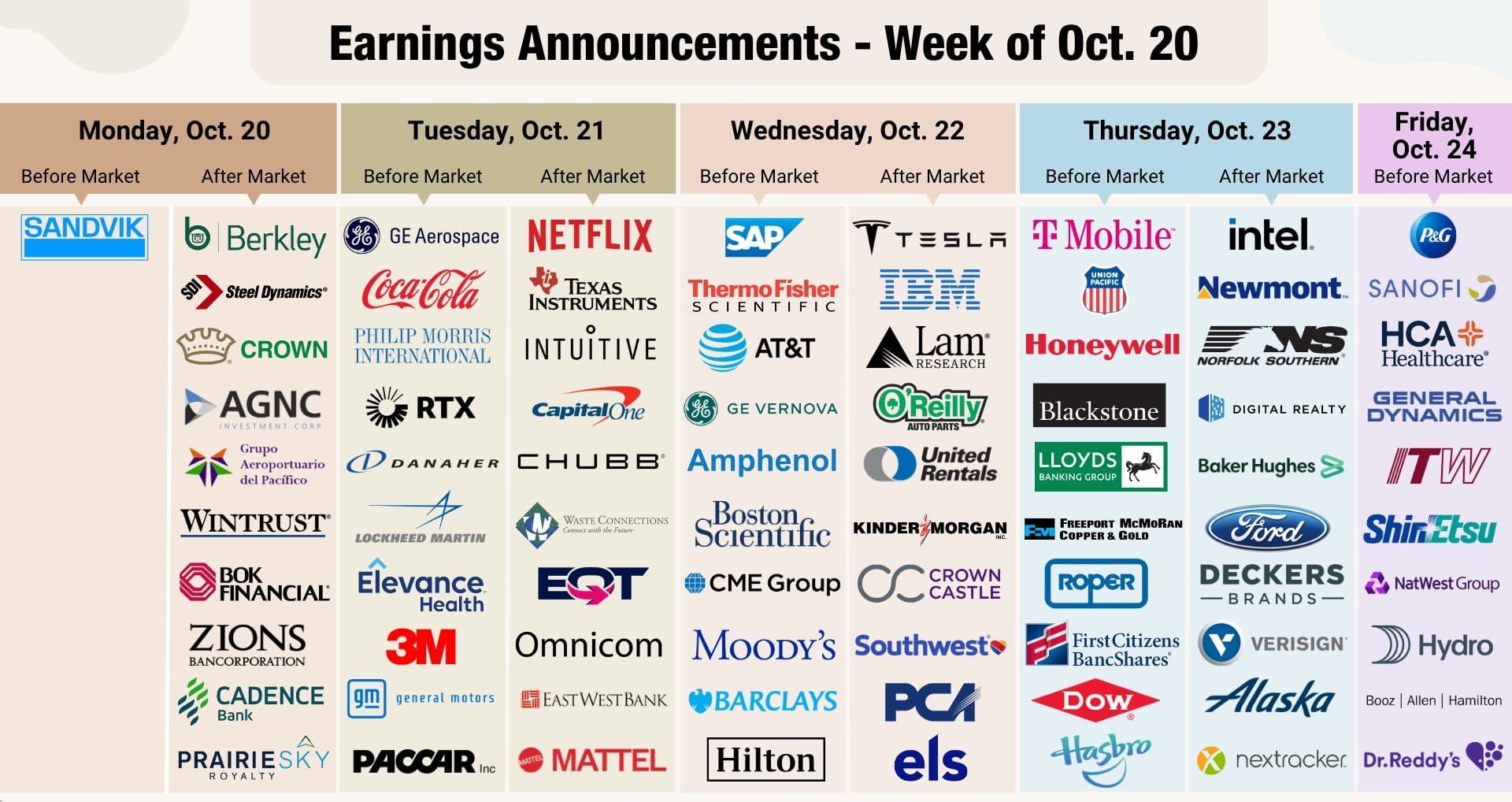Q3 Earnings for the Week of October 20 2025 — Monetary Policy and Geopolitical Strategy
The Most Anticipated Earnings of the week of October 20–24, 2025, arrive during one of the most consequential stretches of the year. Inflation data, shifting monetary policy, and corporate results from global bellwethers will shape how investors position for the final quarter and beyond.
This week isn’t routine—it’s a stress test for confidence. From Beijing to Washington, markets are weighing whether the economy’s soft-landing narrative can survive slowing growth, persistent inflation, and political uncertainty. Every data release and corporate report adds another clue to the global puzzle.
Below, the analysis unfolds through three lenses that together define this turning point:
- Monetary Policy and Inflation Dynamics
- Geopolitical and Structural Shifts
- Q3 Corporate Earnings: Signals of Strength, Stress, and Strategy

I. Monetary Policy & Inflation Dynamics
China’s Loan Prime Rate: Stable Numbers, Hidden Fragility
On Monday, October 20, the People’s Bank of China will set its Loan Prime Rates. Consensus expects no change: the one-year at 3.00% and the five-year at 3.50%. At first glance, stability looks comforting, but it reflects deep caution.
Governor Pan Gongsheng’s “appropriately accommodative” stance hides an economy still battling deflationary undercurrents and a fragile property sector. Rather than cutting aggressively, the PBoC has favored targeted liquidity tools to keep credit flowing without destabilizing the yuan or triggering capital flight.
Growth data reinforce the challenge. Q3 GDP is forecast at 4.7% year-over-year, down from 5.2% in Q2; retail sales have slowed to 2.9%. While exports remain surprisingly solid, domestic demand lags. If momentum weakens further, Beijing may pair fiscal stimulus with monetary easing before year-end—a move that could revive sentiment across emerging markets.
U.S. CPI: The Pivot Point for the Federal Reserve
The most watched data release arrives Friday, October 24: the U.S. Consumer Price Index for September. Forecasts call for headline inflation to rise 0.3% month-over-month and core to match that pace.
Shelter costs may ease, but tariff-related pressures linger. The Fed’s September minutes revealed a split: doves see a softening labor market as license to cut soon, while hawks fear an inflation re-acceleration. Markets price about 54 basis points of easing by year-end, with a November cut most likely.
A hot CPI print could chill rate-sensitive tech stocks; a cooler number might extend the rally that has defined autumn 2025. Either way, this reading anchors expectations for every central bank heading into 2026.
The U.K. and Canada: Shared Challenges, Different Paths
Britain’s September CPI (October 22) is set to jump to 4.0% year-over-year. Base effects in transport costs drive much of the gain, but core services inflation near 4.9% keeps the Bank of England under pressure. With the Autumn Budget looming in November, officials must balance price control against a weakening labor market. Markets see only a slim chance of an October cut, but a 50/50 split by December.
Canada’s CPI (Tuesday, October 21) is the final inflation checkpoint before the Bank of Canada’s October 29 meeting. After August’s surprise drop to 1.9%, analysts seek confirmation that disinflation is entrenched. With core still near 2.9% and job growth firm, Governor Tiff Macklem walks a fine line. A softer reading could cement odds of a December cut and support the loonie’s recent strength.
Japan: Inflation Meets Leadership Change
Japan’s September CPI (due Friday) illustrates its own paradox. Core inflation holds around 2.7%, but analysts expect a rebound to 2.9% as energy subsidies fade. Markets now assign a 44% chance of a 25-bp rate hike by year-end—the BoJ’s first in decades.
Politics add volatility. On Monday, October 21, the Diet votes for a new Prime Minister after the LDP-Komeito coalition collapse. Front-runner Sanae Takaichi is likely to pursue fiscal discipline paired with structural reform—a mix that could align with gradual BoJ tightening. For investors, Japan’s dual transition offers both risk and opportunity in a market long seen as defensive.

II. Geopolitical and Structural Shifts
China’s Fourth Plenum: Laying Groundwork for 2026–2030
Between October 20 and 23, China’s ruling party meets for its Fourth Plenum to draft the 15th Five-Year Plan. Investors watch for three themes:
- Reviving domestic consumption and reducing reliance on investment.
- Accelerating technological self-reliance in semiconductors, AI, and green tech.
- Managing geoeconomic tensions with the U.S. amid tariff threats and export controls.
The tone set this week will signal how Beijing balances stability with innovation through 2030.
Europe: Unity Under Pressure
At the European Council Summit (October 23–24), leaders will confront three pressing issues: Ukraine support, defense readiness, and industrial competitiveness. ECB President Christine Lagarde’s attendance underscores the link between fiscal coordination and monetary stability. With Eurozone PMIs hovering around 51.0, the region’s growth is barely positive. Any hint of fiscal unity could boost confidence in European equities relative to U.S. markets.
III. Q3 Corporate Earnings: Signals of Strength, Stress, and Strategy
The Most Anticipated Earnings week brings the heaviest concentration of Q3 reports yet. Results from Tesla, Netflix, IBM, Intel, Coca-Cola, Texas Instruments, Intuitive Surgical, and Nokia will reveal whether corporate America and its global peers are truly navigating inflation or merely surviving it.
Tech and Innovation
- Tesla (TSLA) reports Wednesday. Consensus EPS: $0.52 on $26.27 B revenue (+4.3% YoY). Despite lower estimates, bullish sentiment prevails. The stock sits 31.9% above its 200-day average, fueled by Cybertruck momentum and autonomy hype. A beat could extend the rally; a miss might trigger profit-taking.
- Netflix (NFLX) ( Tuesday ) projects 17.3% YoY revenue growth and $6.89 EPS. Password-sharing crackdowns and ad-tier expansion are paying off, making Netflix one of the few high-growth stories thriving in a high-rate world.
- Intel (INTC) faces a tough quarter with EPS near $0.01 and revenue down 1.3%. Yet investors remain hopeful about its foundry strategy and CHIPS Act subsidies. A surprise beat would validate its turnaround narrative.
- IBM is expected to deliver steady 7.5% revenue growth to $16.09 B and $2.43 EPS. Hybrid cloud and AI consulting are bolstering margins, making it a defensive tech play amid volatility.
Industrials and Materials
- Cleveland-Cliffs (CLF) may post a $0.48 loss per share despite 7.5% revenue growth. Input costs and soft auto demand hurt margins, but the stock’s 37% climb above its 200-day average suggests investors are betting on a 2026 recovery.
- Newmont Mining (NEM) expects $1.27 EPS on $4.92 B revenue (+6.8%). With gold near record highs, Newmont remains a preferred hedge against policy risk and geopolitical uncertainty.
Consumer and Electronics
- Coca-Cola (KO) continues to shine as a defensive staple. Forecast: $0.78 EPS on 4.9% revenue growth. Its pricing power and emerging-market exposure show how consumer brands can thrive even as budgets tighten.
- Texas Instruments (TXN) bridges tech and industrial cycles with expected revenue growth of 11.8%. Its guidance range of $4.45–$4.80 B underscores robust demand for automotive and industrial semiconductors — a key indicator of real-economy health.

Healthcare and Telecom
- Intuitive Surgical (ISRG) forecasts 18.2% revenue growth and $1.99 EPS. Adoption of its da Vinci systems remains strong, but valuation skeptics keep short interest elevated.
- Nokia (NOK) reports Thursday with revenue expected to rise 13.4% YoY. Its 5G infrastructure expansion across Europe and India positions it as a viable Huawei alternative in the geopolitical tech race.
IV. Synthesis: What This Week Reveals
The Most Anticipated Earnings of October 20 coincide with a macro turning point. Taken together, they illustrate a world economy fragmenting across three dimensions:
- Inflation divergence — sticky in the U.K., moderating in Canada, volatile in Japan, subdued in China.
- Policy fragmentation — the Fed leans dovish, the BoE hesitant, the BoJ tentative, the PBoC strategic.
- Earnings polarization — tech and staples show resilience; industrials and materials struggle with margin pressure; turnarounds (INTC, NOK) depend on execution.
For investors, the message is selectivity. Broad index rallies mask diverging earnings quality. The winners into 2026 will be companies with pricing power, operational discipline, and strategic alignment to structural trends — AI integration, supply-chain resilience, and consumer value sensitivity.
Outlook Heading into Q4 and 2026
As Q3 wraps up, investors face a delicate balance. The soft-landing scenario remains intact but not guaranteed. If U.S. inflation cooperates and China adds measured stimulus, risk assets could extend gains through year-end. However, any shock—from geopolitical flare-ups to policy missteps—could quickly reverse momentum.
The week of October 20 will echo through markets for months. Those who decode its signals early and position with discipline will be best placed for what comes next.












